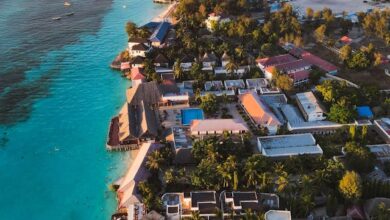When is the Best Time to Visit Ngorongoro Crater in Tanzania

The best time to visit Ngorongoro Crater depends on your preferences and plans for your safari in Africa. The Ngorongoro Crater is a year-round safari destination because the wildlife remains in the steep-sided crater throughout the year.
Deciding when the best time is to visit Ngorongoro Crater is more about your tolerance for crowds than it is about finding the optimal time for game viewing.
What is Ngorongoro Crater?
Before we unpack the best time to visit, here’s a quick explanation of the crater. The Ngorongoro Crater is a must-visit destination for nature lovers and wildlife enthusiasts. Located in Tanzania, East Africa, this unique safari destination is home to an incredibly diverse range of wildlife, including the Big 5 animals, within the walls of an extinct volcano.
Ngorongoro Crater is a remarkable natural feature and a UNESCO World Heritage Site. It is a 25-kilometer (15-mile) wide geological marvel formed around three million years ago when a massive Rift Valley volcano erupted and collapsed. What remains is the world’s largest inactive, unbroken, and unflooded caldera, a 610-meter (2,000-feet) deep crater covering an area of 260 square kilometres (100 square miles).
Ngorongoro Crater is a destination on the popular Tanzania Northern Safari Circuit. The crater floor forms a natural amphitheatre home to an incredible array of wildlife, including elephants, lions, hyenas, zebras, wildebeest, and the endangered black rhino. Additionally, the crater boasts a soda lake, Lake Magadi, at its centre which attracts flamingos and other water birds. Small streams drain from the lake, providing this ecosystem with water, along with Ngoitokitok Spring near the eastern crater wall draining into a swamp area popular with elephants and hippos.
Now, let’s see when the best time is to visit this Tanzanian wildlife haven.
The Best Time to Visit Ngorongoro Crater
The best time to visit Ngorongoro Crater depends on your interests and plans for your holiday. For a full safari adventure, many choose to combine their Ngorongoro visit with the world-famous Serengeti National Park. Others choose to combine a Ngorongoro Safari with some beach time on Tanzania’s exotic spice island, Zanzibar. Here are the key seasons to keep in mind when planning your trip:

The Dry Season (June to October) – Peak Season
This is the time to experience the Great Migration in Serengeti National Park. While the animals do not stick to our calendars and sightings are never guaranteed, June marks the early stage of the Great Migration when the enormous herds begin to move from the southern Serengeti. By July/August the migration is in full swing, and this is the time to witness the herds crossing the Grumeti River with the associated drama of crocodiles and other predators lying in wait. In these months, there is a covering of short grass on the floor of Ngorongoro Crater which allows for superb wildlife viewing.
On Zanzibar Island, the dry season means lower humidity, making for slightly cooler temperatures. At this time of the year the ocean is calm and clear, excellent conditions for any snorkeling and diving activities. However, be warned, this is peak tourist season in Tanzania which means higher rates and many more tourists.
The Shoulder Season (January/February)
January marks the start of calving season in the Serengeti and Ngorongoro Crater when the vast herds of wildebeest and zebra give birth to their young, and predators are on the prowl. There is a good chance that you will witness newborn calves taking their first wobbly steps. The Shoulder Season falls between the short rains of November to December and the long rains, of March to May, so you can expect mostly dry weather with occasional showers. There are also fewer crowds compared to peak season, which makes for a more pleasant safari experience.
On Zanzibar Island the weather is hot, but humidity comes down after the rainy season. This is a lovely time to soak up the sunshine and enjoy a relaxed beach break. There are relatively fewer tourists than peak season which means that the place is less crowded.
The Short Rainy Season (November to December) – Green Season
The Green Season is a lovely time to visit the Ngorongoro Crater and Serengeti. The lush, newly green landscape is a treat for the wildlife and fewer safari vehicles abound. The vast herds of the Great Migration start moving back to Southern Serengeti following their time in the Masai Mara of Kenya. Migratory birds also start to arrive in their thousands, making for excellent bird spotting. Travel plans may be interrupted by rain showers, but these are generally short-lived with blue skies emerging soon after. This less popular season also means lower safari prices.
On Zanzibar Island, this is a transitional season with occasional rains followed by blue skies. There are fewer people around and rates are more reasonable.

What makes a Ngorongoro Crater safari one of the best in Africa?
Now you know when the best time to visit Ngorongoro Crater is. Before you go, take a quick look at why it’s worth visiting the crater.
The unique geology of the Ngorongoro Crater sets the stage for some of the easiest and most rewarding game viewing in East Africa.
It is the wildlife encounters on the crater floor where the safari adventure truly begins. The high concentration of animals includes the Big 5 safari animals (lion, elephant, buffalo, leopard, and rhinoceros), and vast herds of wildebeest, zebras, and antelope grazing on the open plains. The many habitats of the crater floor also attract a fantastic diversity of birdlife, from flamingos around the soda lake to numerous raptors soaring above. Ngorongoro Crater safaris are known for their unique predator-prey interactions in this densely populated wilderness.
Best Time to Visit Ngorongoro Crater, Tanzania – In Short
If the Great Migration is on your bucket list, join the crowds from June to October to be part of this famous spectacle and be sure of excellent animal sightings in Ngorongoro Crater.
However, be warned that you will be sharing this experience with many other safari visitors. For less crowded safaris, it is advisable to visit during the January/February calving season or take advantage of the lower prices during the Green Season if you wish to stay away from the crowds.

By Sue Maude
Sue is an adventurer and travel writer for African Budget Safaris. Bitten by the travel bug at an early age, Sue spent her twenties backpacking the world before returning to South Africa. These days she likes nothing better than a road trip and will not stop until she has driven every road in the country! The African bush is her favourite location, and she is passionate about sharing this love with the world. When she is not on the road, Sue lives close to the beach in Cape Town.





